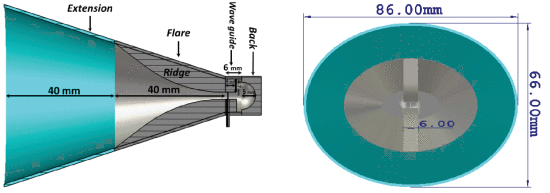Rice university researchers develop sweet new way of 3D printing vascular networks
New biomaterial discovery enables 3D printing of vascular structures
London: 3D Printing the Double-Ridged Horn Antenna for Biomedical Monitoring
Researchers are looking into ways to optimize biomedical monitoring, with their results outlined in ‘A 3D Printed High-Dielectric Filled Elliptical Double-Ridged Horn Antenna for Biomedical Monitoring Applications.’ Seeking to make further impacts in the field of medical science, the team from Queen Mary University of London has 3D printed an innovative device for sensing applications with wireless technology—based on ultra-wideband devices initially created for short-range wireless communications.

The in-house measurement setup based on the open-ended coaxial probe technique, used for the characterization of the dielectric materials.
Created to work within UK Communications Industries (Ofcom) and the Federal Communications Commission (FCC) regulation of UWBs, the new device has been found to offer depth suitable for penetration in scanning skin, muscle, and fat, with signals able to sense layer thicknesses. Wide-band technologies are often used for short-range communication due to:
- Low power
- High data rates
- Multipath immunity
- Simultaneous ranging and communication
While this type of antenna is not new, the use of 3D printing is novel. The double-ridged horn has been a topic of research over the years for researchers because of the benefits, leading to a more effective answer to refining accuracy in biomedical scanning. And while 3D printing can offer greater affordability in many cases, here the research team was concerned about cost-prohibitive fabrication, so they compared materials, ultimately settling on in-house 3D printing with ABS.
The shape of the horn allows for better operation overall, and the high dielectric material allows for a miniaturized design that also reduces reflection and is both easy and affordable to make. With an extension, the scientists were able to expand on the antenna and prevent signal-overlapping issues.

Modeled extended EDRH antenna with the structural labels and the dimensions for the extended section.
“The optimal approach is to extend the outer aperture of the antenna, and to define, the antenna outer aperture length, so the scanning tissue area can be placed in the far-field region,” stated the researchers. “This has added more complexity to the fabrication and realization of the device with the increased cost, but on the other hand, it has made it more stable in its operation, and free of any destructive interference signals and noise.”
The team used the Stratasys Objet30 Prime 3D printer for creating their prototype, finishing it with clear Vero polyethylene, stating that hardware and materials not only offered high resolution, accuracy, and conductivity, but also affordability in fabrication.
Measurements were found to be accurate also, as they addressed concerns regarding individual and other influences like scanning areas and layer structure but concluded that there should be very little variance between ‘permittivity and thickness.’ If an impact on the results was noted, the researchers explained that added calibration measures could be taken with an open-ended probe, with software producing the results.

(a) 3D-printed EDRH antenna using the polyethylene material. (b) 3D-printed EDRH antenna, as conductive-painted and fed with a semi-ridged SMA connector. (c) 3D-printed EDRH antenna filled with the high-dielectric mixture.
“This design incorporates the extension for locating the antenna in the far-field region of the scanning area, for the plane-waves to penetrate more directly into the body. Moreover, the antenna can operate at the lower frequency band of WB to exhibit a better penetration depth and impedance matching using the mixture for the biomedical application, which monitoring very deep inside the body is the main objective of the system,” concluded the researchers at the end of their study.
3D printing has offered much greater expansion opportunities for scientists and engineers interested in creating better devices for sensing and monitoring, from automotive sensors to electrochemical sensing, and 3D printed models for better monitoring.
What do you think of this news? Let us know your thoughts! Join the discussion of this and other 3D printing topics at 3DPrintBoard.com.
[Source / Images: ‘A 3D Printed High-Dielectric Filled Elliptical Double-Ridged Horn Antenna for Biomedical Monitoring Applications’]
The post London: 3D Printing the Double-Ridged Horn Antenna for Biomedical Monitoring appeared first on 3DPrint.com | The Voice of 3D Printing / Additive Manufacturing.
London: Researchers Use Drop-on-Demand Method to 3D Print Latex & Rubber
 Researchers at Queen Mary University of London are exploring a new drop-on-demand (DoD) method with latex, and rubber. They explain their work in ‘Additive Manufacturing with Liquid Latex and Recycled End-of-Life Rubber,’ detailing how they have been able to create a new method to overcome some of the challenges in compatibility between materials and inkjet systems.
Researchers at Queen Mary University of London are exploring a new drop-on-demand (DoD) method with latex, and rubber. They explain their work in ‘Additive Manufacturing with Liquid Latex and Recycled End-of-Life Rubber,’ detailing how they have been able to create a new method to overcome some of the challenges in compatibility between materials and inkjet systems.
The authors, Miguel A. Quetzeri-Santiago, Clara L. Hedegaard, and J. Rafael Castrejón-Pita are aware that while many companies have been interesting in using elastomers and rubbers in additive manufacturing, the end product has often been inferior to those made through traditional processes. Liquid elastomers have also been considered as an option, but viscosity restrictions prohibited their use, or success in fabrication. Clogging and agglomeration have also been stumbling points.
With drop-on-demand inkjet printing, the researchers considered a way to bypass previous challenges and take advantage of printing with droplets that can be printed close to each other, subsequently coalescing and creating strong layers. The process can be driven by different types of pressure pulsing that cause the droplets to be ejected from the nozzle. Advantages of this process include:
- Lack of substrate contact, preventing nozzle contamination
- Higher printing speeds
- Greater control
- Variability in droplet volume and speed
- Flexibility in production and options for customization
- Potential for recycling rubber
Two printheads, one small and one large, were created in the lab, with pulse generators driving the actuator—and each pulse resulting in one drop:
“The small printhead uses a 20 mm diameter loudspeaker (8 Ohms, 0.1 W), has an inner liquid reservoir volume of 4 mL, and a conical nozzle with an outer diameter of 1.0 mm,” stated the researchers. “The larger printhead uses a Visaton Structure-Borne Driver loudspeaker (8 Ohms, 25 W) with a 9 mL volume reservoir and a 0.85 mm conical nozzle.”
The inks used in this research were as follows:
- Pure liquid latex – from Liquid Latex Direct (UK), containing 60 percent natural rubber, 40 percent water, and less than .3 percent ammonia.
- Liquid latex – also from Liquid Latex Direct, containing 60 percent natural rubber, 40 percent water, and less than three percent ammonia.
“While being able to inkjet undiluted liquid latex is an interesting prospect in itself, the ability to add solid particles to form a colloidal ink widens the market applications for this technique,” state the authors. “The addition of particles can be used to reinforce the positive mechanical properties or improve other properties such as thermal and electric conductivity, stiffness, or elasticity of a given construct. Moreover, this includes the possibility of reusing discarded rubber materials, in the form of micronized rubber powder (MRP), in the manufacturing of new products.”
For 3D printing, the research team loaded each printhead, controlling backpressure and monitoring pulse duration and intensity. Each droplet was meant to coalesce into a form, building with layers. They used two different methods for curing, via ambient air and hot air. Continuous printing of the pure liquid latex was noted as ‘consistent and reliable’ in timeframes of up to one hour.

Printing with liquid latex. (a) The experimental setup showing the Grbl controlled stage and the printhead mounting (the 9 mL reservoir printhead is shown); (b) an example of a single layer structure made from pure liquid latex, using a droplet interval of 2.5 s with two close-ups of the corner resolution; (c) varying the droplet interval keeping the pulse signal and nozzle diameter constant: from left to right increasing the interval length from 1.0 to 5.5 s (inserts show bird-eye perspective). All scale bars 1 mm.
In adding parlon powder or micronized rubber powder (MRP), the authors discovered that both materials had a tendency to clump together in the nozzle, and in printing with MRP, ‘solid tire rubber could be clearly visualized in most of the droplets.’ The researchers theorize that a better mixing procedure and more vibration of the printhead reservoir could improve these issues. They also noticed that MRP particles combined with latex decrease the amount of elasticity but do not have any impact on stiffness at all. Overall, their work in 3D printing high solid content latex was successful though, and the researchers stated that this study offers ‘new possibilities’ for recycling tire waste.
“The capability of printing with a high particle loading (high solid content latex with the addition of parlon powder or MRP) and a heterogeneous particle size distribution shows that the printhead design can operate in a wide range of solid particle loadings,” concluded the researchers. “This is a great advance, as most conventional inkjet-based 3D printers cannot operate with viscous liquids or liquids with solid particle loading.”
“A reliable method of AM with liquid latex would bring great merits to the industry, by reducing cost of manufacturing (no molds needed) and adding an unprecedented degree of flexibility in the manufacturing process. Moreover, the study has highlighted a novel method of recycling end-of-life tires. With this work, it is foreseeable that in the future we can create 3D printed objects with rubber tire waste, expanding the current recycling and waste management methods.”

Liquid latex with rubber particle loading. (a) Time-lapse of the printhead mounted to the x/y stage, jetting pure liquid latex (1 drop/1.5 s) (scale bar 1 mm); microscopy images of liquid latex with (b) 3.5 wt. % and (c) 6.7 wt. % parlon loading; (d) a defined array made by jetting liquid latex containing 6.7 wt. % parlon powder; (e) cast rubber samples of pure liquid latex and with increasing MRP loading (5, 9, and 16 wt. %); (f) a graph of Young’s Modulus, determined using indentation and tensile testing, of cast samples with 5, 9, and 16 wt. % MRP (control; 0 wt. % MRP), and printed samples of one and four layers (1LP and 4LP, respectively) (control thin: a pure latex cast). Data reported as mean ± standard deviation; (g) example of elongation of a one layer printed sample (1LP) under a constant strain tensile test (insert: original sample) and (h) tensile stress and strain at breaking point, derived from the constant tensile strain experiments. Data reported as mean ± standard deviation. MRP, micronized rubber powder.
The science and study of materials plays a huge part in 3D printing, and there has been great interest in exploring rubber also to its flexibility, as well as using it in the tire industry, and creating other materials like TPU to simulate its qualities. Find out more about liquid latex in 3D printing here. What do you think of this news? Let us know your thoughts! Join the discussion of this and other 3D printing topics at 3DPrintBoard.com.
[Source / Images: Manufacturing with Liquid Latex and Recycled End-of-Life Rubber]

